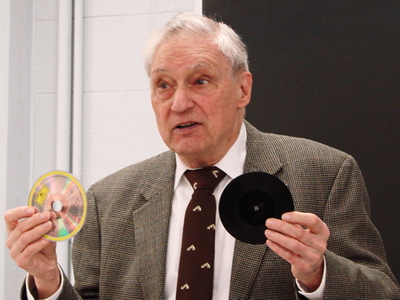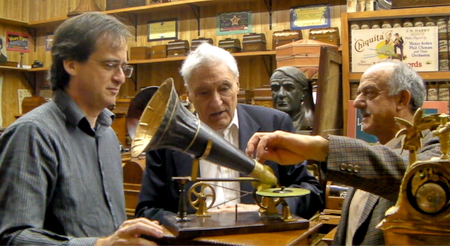|
What Did it Take to Get us Here?
by Oliver Berliner
As this member’s salute to CAPS’ half-century, I’m
taking the liberty of repeating much of what my fellow
Canucks already know, in hopes of filling a hole or two
in this saga, but also with the thought that enthusiasts
in other parts of the world may read it and get their
questions answered.

|
|
Oliver Berliner presenting at a CAPS meeting on October 30, 2011
|
|
|
My grandfather, the Great Emile, established the first
Berliner Gramophone Company in the American town
of Newark, state of Delaware, in 1887 – a decade after
selling his telephone patent to a Canadian of Scottish
heritage who’d migrated to Boston, U.S.A, from his
birthplace in ‘New Scotland’ (Nova Scotia province,
where his remains now reside) to seek his fortune.
This Alexander Graham Bell, a teacher of deaf people,
had been engaged by her father, to teach his hearing-
impaired Mabel Hubbard. Later, Bell would marry his
student and be invited to reside with her in Gardner G.
Hubbard’s Boston residence, where he would be
provided with funds to support an electro-acoustics lab
as well as a lab assistant.
When Bell cut his hand and called out to his assistant,
Thomas Watson, it was Watson who heard the first
transmission by Bell’s invention, via the words, “Mr.
Watson, come here; I want you”. With those words the
telephone (from the Greek: distant sound) was born. By
way of what must have been destiny, in the year 1876
the United States was celebrating its centenary in
Philadelphia where, fortuitously, the president of Brazil
insisted on trying Bell’s creation there on display, and
exclaimed, “My God, it talks!”.
Largely heretofore ignored by the press, the Brazilian’s
interest brought newspaper reporters scurrying to
Bell’s exhibit. Needless to say, it was not long afterwards that inventors and wannabes began to create
and patent an improved telephone. In fact, with father-
in-law Hubbard in the process of launching the
telephone industry, Bell sent a representative to the
U.S. Patent Office to see who’d leaped into the fray,
and with what. The reviewer returned to Boston to
advise that, of all he’d seen there was but one that
offered what Bell needed...a telephone circuit designed
by an obscure 25-year-old Washingtonian named Emile
Berliner.
In due course, Emile’s landlady sent a message to him
at the dry-goods store where he was working for $3 a
week, notifying him that a Thomas Watson, an assistant to Alexander Graham Bell, was waiting to see him.
In that meeting, Emile demonstrated what would be
the microphone (from the Greek: tiny sound)...a
modification of a child’s toy drum that was destined to
set the scientific world on its ear. For in addition to
establishing what was deemed by experts to be
impossible – the ability to pass current between
contacts that didn’t touch one another - but also a
circuit as described in the patent where a.c and d.c
voltages were carried over the same wires.
“We will want that”, said Watson. “You will hear
from us”. Not long after, Emile received an offer from
American Bell Telephone Co. to purchase the Berliner
telephone patent which contained the unique circuitry
needed to make Bell’s telephone a practical reality.
With the sale to Bell, as the telephone transmitter, the Berliner variable-
resistance microphone was used in all the world’s
telephones for the ensuing 100 years. It’s adoption
saved The Bell System from destruction at the hands
of the powerful Western Union Telegraph Company,
relying on a (rendered-) worthless Thomas Edison
patent. Further, along with the assignment to Bell of
the Edison patent, Western Union was prohibited from
ever entering the telephone business’'; its telephone
poles became Bell’s, as did the Western Electric Company.
A decade later, the then Great Emile introduced a
method of mass-producing unlimited perfect copies of
a single recording, along with it a machine to play
those records, which he named the gramophone (from
the Greek, sound of words). Emile established the first
Berliner Gramophone Company in the Delaware city of
Newark, because the Duranoid Company there was
stamping out of celluloid large, fancy buttons for
m’lady’s dresses; and my grandpa recognized
that disc records could be pressed the same way.
Sadly, unable to obtain financing to “get into business”, his company closed its doors.
But by 1893 Emile had obtained the long sought
financing through Mr. Thomas Parvin, and it was
agreed that this Berliner Gramophone Company would
be located in Philadelphia, and though bearing his
name, Emile would own but 10% of it yet would receive
royalties for the use of his precious patents. The
Philadelphia location was extremely close to Newark
for convenient disc-pressing there, as before (discs
were now comprised of mainly a shellac paste). But the
principal reason for the Philly location was that Emile
could have convenient access to the counsel of Mr.
Max Levy, the inventor of photo-engraving – the
method of reproducing photographs in newspapers
and magazines. It was this method that Emile used to
create stampers from which disc records could be
pressed. He called it “etching the human voice”.
By mid-1900 when the “His Master’s Voice” Berliner
trade-mark came into use in USA and Canada, discs
had come to be so much in demand that the leading
cylinder maker, an Edison licensee known as the
Columbia Graphophone Company, had realized that
the future of the record business lay in discs, despite
both Edison and Bell having regarded the cylinder as
superior. Columbia’s general manager engaged a
lawyer named Phillip Mauro to determine whether the
Berliner disc playback method – the gramophone –
infringed on the “floating stylus” patent of A.G. Bell’s
cousin Chichester and his associate Charles Sumner
Tainter (an acquaintance of Emile’s).
Mauro reported to Columbia that the Berliner patent
did not infringe Bell-Tainter’s. But so anxious was
Columbia’s owner to get into the disc business
that he’d earlier spurned, that he ordered Mauro to sue
the Berliner interests, anyway.

|
|
Oliver Berliner examining a Kämmer & Reinhardt (Berliner) gramophone
during a visit to see Domenic DiBernardo’s collection.
(Mark Caruana-Dingli, Oliver Berliner, Domenic DiBernardo)
|
|
|
Who were the Berliner interests? There was Emile
Berliner; the United States Gramophone Company,
which controlled his patents; the Berliner Gramophone Company; Eldridge Reeves Johnson –
a subcontractor manufacturing Berliner gramophones; and the
Berliner Company’s master distributor, the National
Gramophone Company and its owner, Frank Seaman.
Unmolested was the 1900-launched Berliner Gramophone Company of Canada which had recently opened
a St. Catherine Street retail store in Montreal and was
pressing discs in rented space from - would you
believe? - Bell-Canada.
At this point it should be noted that the not-so-secret
owner of Columbia was Alexander Graham Bell. Sadly,
Bell had become willing to forsake his decades-old
mutually rewarding relationship with Emile Berliner,
who’d recently even become a customer, by trying to
destroy him with a dishonest claim. But putting two
and two together, it becomes obvious why Bell would
leave Berliner-Canada alone.
Cutting to the chase, here’s what “went down”.
Seaman, who’d long resented Berliner Company's strict
limitations on him and was anxious to destroy him,
accepted Columbia’s offer for release as a defendant if
Seaman would testify that: the Berliner gramophone
infringed on the ‘floating stylus’ patent. Such testimony, which was allowed in court, was meaningless
because Seaman was no more qualified than the ‘man
in the moon’ to function as a legalities expert.
Prior to trial, Eldridge Johnson had managed to
extricate himself as a defendant. Upon doing so, he
immediately arranged with the Berliner interests that,
under the Consolidated Talking Machine Company brand, he would manufacture Berliner
discs and gramophones and when Berliner prevailed at
trial he would account. It thus became legally necessary for Emile’s U.S. Gramophone Company to sue
Consolidated for patent infringement; and per tacit
agreement, this was done.
After a lengthy trial, at long last, the verdict: (As Mauro
foretold) the court ruled that the floating stylus was
propelled by a feedscrew while the gramophone’s
reproducer was propelled by the groove on the disc.
Seaman’s own company and its products,
the Zonophone player and disc records which had
infringed the Berliner patents, were awarded to Emile
as damages. Columbia continued to be prevented from
the manufacture of disc records and players. No one
else could engage in the business of making discs and
disc players.
But the loss of income caused by Columbia’s lucky,
unprecedented court-ordered injunction that prevented
during trial the Berliner Company from doing business,
had left the Berliner interests bereft of funds – while
Eldridge Johnson had prospered by it - and it was agreed
that a new company would be formed to take over all
Berliner’s and Johnson’s former activities. Johnson
would be the largest shareholder, Berliner next.
Berliner would assign to the corporation all his patents
and trade-marks as well as all National assets; by
choice, he’d not be a director nor employee. Thomas
Parvin would be a non-employee director. The Berliner
Gramophone Company of Canada Ltd., would be the
new corporation’s Canada outlet. To commemorate the
Berliner court victory, Johnson named the corporation
the Victor Talking Machine Company.
Johnson decided not to use the word, gramophone,
claiming it should be exclusive to Emile. Thus all record
players were to be called talking machines. And
ironically, it was not long before Johnson offered to
license to Columbia that which it had tried to steal. A
half-century and two world wars later Columbia’s sales
would exceed those of Victor Records, by then known
as RCA Victor and whose Canada operations, resulting
from my father, Edgar M. Berliner’s 1924 sale of
Berliner-Canada to Victor-Camden, would be RCA Victor
Co. of Canada Ltd.
|